Irene Crosses the North Atlantic
Our last post left us in St Peter’s, Nova Scotia, with us diving to scrub Irene’s bottom in preparation for crossing the North Atlantic to Ireland.
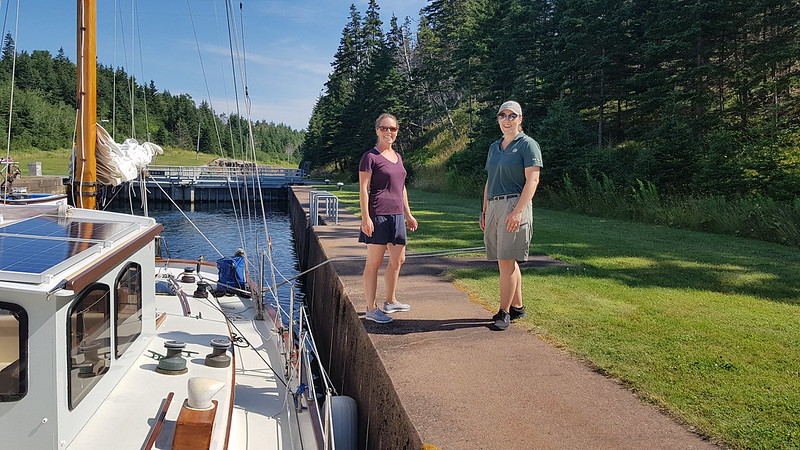
We departed on a Friday – August 3rd, 2018 – in violation of the prohibition “Never Set Sail on a Friday.” We tend to take sailor’s superstitions with a grain of salt. After all, there are so many of them! So we whistle when we are cheerful, carry bananas aboard when we can, and don’t worry in the least that half our crew are women. The weather looked good for us with just the right wind, not too much or too little, and that’s much more important than any old superstition.

The first few days we sailed closehauled in thick fog towards the south coast of Newfoundland. As we got closer to the island the wind backed until we were forced to tack to clear Cape Race. So, Irene zig zagged her way up the great circle route. This is a rare thing for us – sailing upwind on the open ocean – we usually don't to avoid boat damage and crew fatigue, and often progress is minimal - but this time our options were limited by land to the north. We found that even though it was impossible to cook (beyond boiling water) the waves were small enough that we were making good progress. We were running out of sea room on starboard tack (the favored tack) as we closed in on Cape Race so going about was needed if we wanted to go to Ireland instead of South Africa.
An interesting thing happened on one of Ginger’s watches. She could hear half of a VHF conversation between a helicopter and a distant Coast Guard ship or shore station. She realized that the helicopter was reporting the status of a capsized but still floating fishing vessel – definitely a danger to us day or night considering that the fog was so thick we couldn’t see Irene’s bow clearly even at high noon. And radar couldn’t be expected to reliably pick up a target awash in the waves. Luckily, at one point the helicopter pilot reported the position of this wreck (the Tommy Evans) which Ginger marked on the chartplotter so we knew where not to go. Good thing, too – our course took us just a few miles from the floating wreck.

The fog stuck with us for ten days. Then on one glorious morning, the sun came up! We enjoyed a couple of days of weak sun and light winds, still making good progress on the great circle course. Our HF radio was not working, when we spotted a bulk carrier heading our way we gave him a call to get a weather update. The watch officer answered quickly, but his weather information was limited, and all he could tell us was that there were no storm warnings in the next two days! We notice that with increased use weather routing services that many commercial ships officers aren’t as informed about weather as they were in the old days. It didn’t really matter to us because we don’t have the speed to maneuver around storms – once committed to a crossing we take what we get – but it is sometimes nice to know what is coming. Normally at sea we get good information (gribs) over HF radio but we had been plagued with a recurring problem on this passage. Our radio is working perfectly coastwise but won’t tune at sea! Intermittent faults are so hard to diagnose.
On day twelve the fog closed back down on us. This mid ocean fog was not quite as thick as the Canadian version and we could see Irene’s foredeck just fine, but we weren’t going to get suntanned or get any power from the solar panels. We ran the motor for a few hours every other day and charged the batteries, made water, and ran our Russian made hydronic heater to warm up and dry out the cabin.
On the fourteenth, we were visited by surfing pilot whales and dolphins. It was so nice to see fellow mammals on the high seas! Ginger cooked up a magnificent sausage and egg breakfast and we ran the heater for hot water baths and hair washing. Life can be very good at sea.
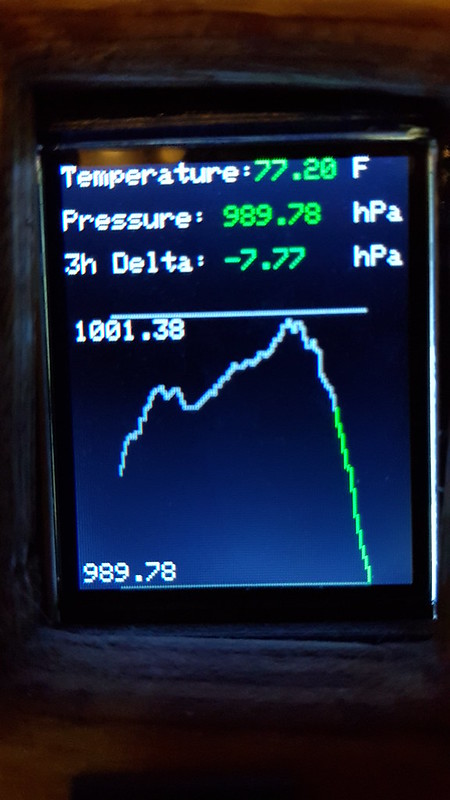
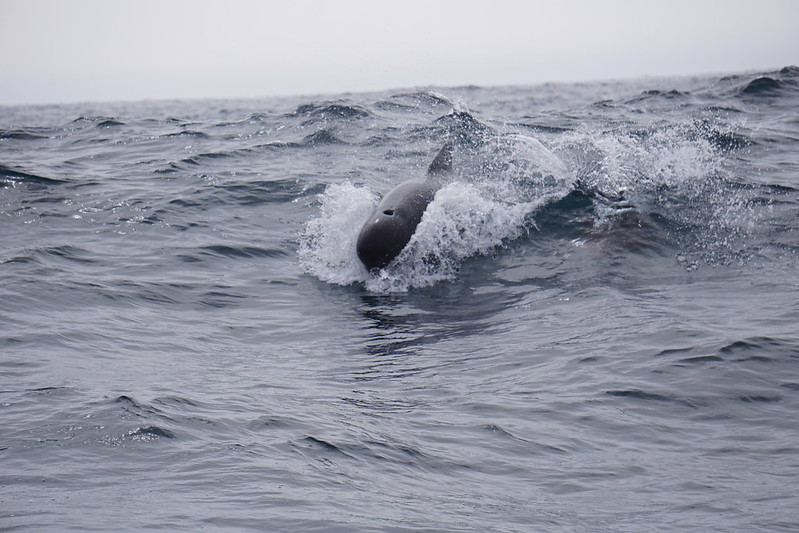
7.77 hPa drop in 3 hours means lots of wind is coming!
The barometer started to plummet so we expected some weather to arrive. Gradually wind and sea rose, and sails were reefed and furled in sequence. We sailed on under jib for 24 hours. By nightfall that next night we were sailing under a scrap of jib alone. By two in the morning Irene was taking a beating, so we lashed the tiller down to leeward. Time to park the boat! Irene’s motion eased and her crew headed down below to take it easy. We checked for traffic (there was none) every fifteen minutes by radar or going out on deck for a look, but mostly we stayed wedged in our storm bunks. Twenty eight hours later we could hear the wind easing and were able to resume sailing, under jib and reefed mizzen, just as the weak dawn revealed a bleak wild seascape of tumbling breakers. We later found out that we had ridden out subtropical storm Debby.
Two days later, the barometer started dropping again (with a sharper drop this time) and we repeated the same process of progressively reducing sail and before long we were hove to again. We were a mere 88 miles from Ireland. At 3:30 AM on August 19, nine hours later, we were able to set a bit of sail and head towards Bantry Bay, on the west coast of Ireland. We later found out that we had ridden out subtropical storm Ernesto. Sheesh! Still, by North Atlantic standards, our foggy (all but two days) crossing had gone well.
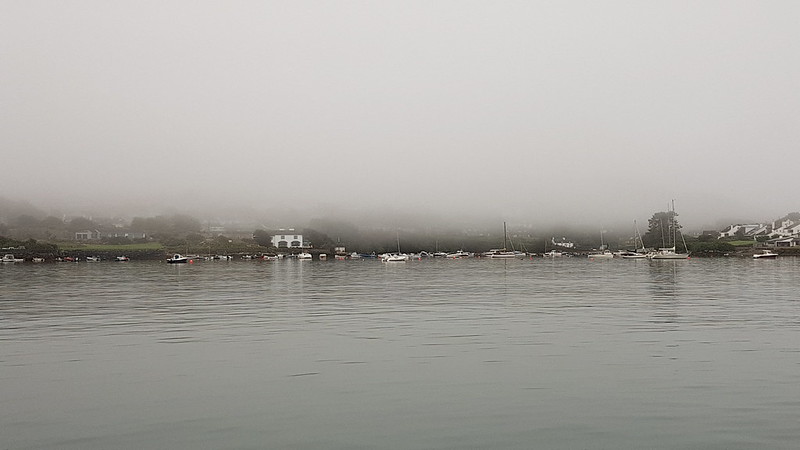
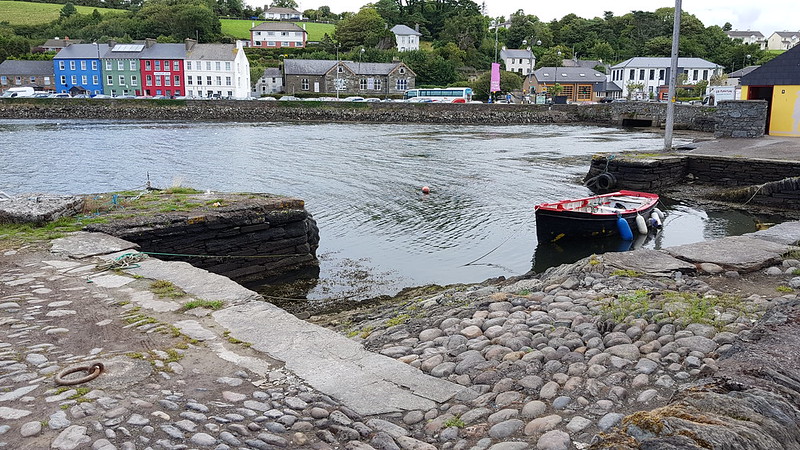

By late afternoon we were well into Bantry Bay and were catching our first glimpses of fog shrouded green Irish shores. By early evening we were tied up to a pontoon at the old Bantry breakwater and were finding out how lucky our choice of landfall was. We had expected to anchor (our chart and pilot book information showed no pontoons or floats) so the newly installed pontoons were a pleasant surprise. There was no need to launch the dinghy to get ashore. And fresh water was available on the pontoon to rinse Irene’s salt soaked decks and rigging and swap out our heat exchanger. The moorage fee was reasonable, a large grocery store was nearby, and the picturesque town was all that we hoped a small Irish town might be. We enjoyed our first pint of Guinness in an ancient dark pub and toasted to the safe crossing. It was a respectably quick one at 16 days, too, especially if you subtract the day and a half we had spent hove to!
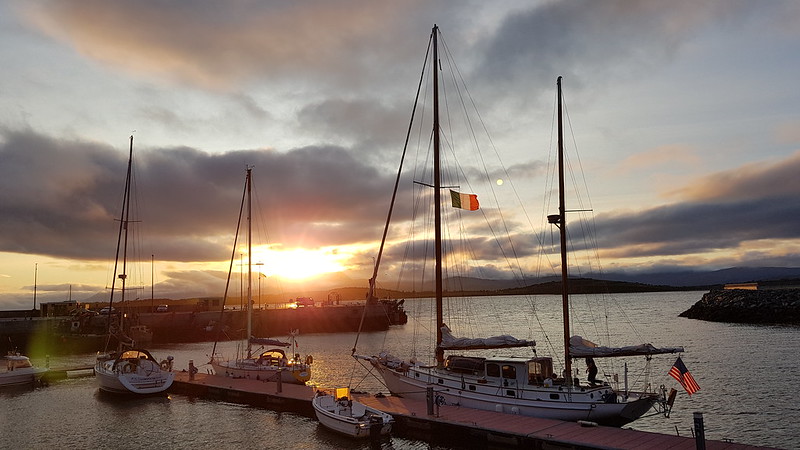
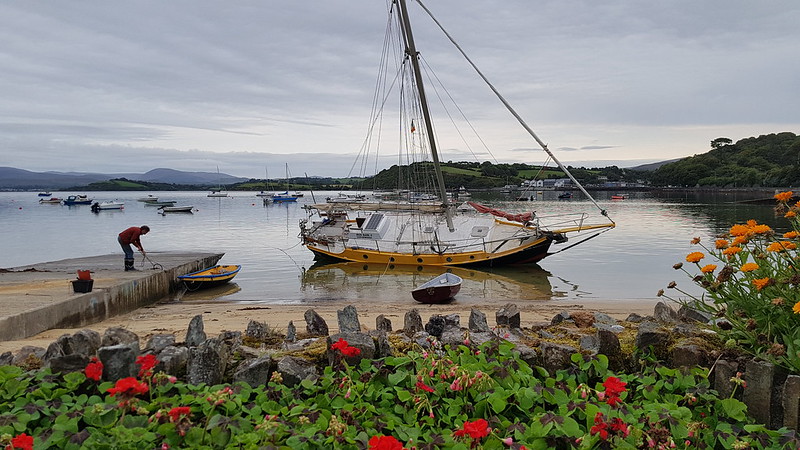
We were only in Bantry a day before a mutual friend in South Africa reunited us with Trevor on Ironbark, last seen in Chile. Ironbark is a 35 foot steel gaff cutter, and Trevor is an amazing singlehander who casually sails from ocean to ocean spending an enormous amount of time in cold and stormy places. He’s wintered over on Ironbark in both the Arctic and the Antarctic! He had recently arrived from New Zealand by way of Antarctica and the Falkland Islands. Trevor spends a lot of time sailing stormy seasons and stormy parts of the world (including the Southern Ocean) and uses his Jordan series drogue seriously. The 2018 Golden Globe racers (there are now three rescues and abandoned boats due to pitch poles, rollovers, dismasting) could maybe learn from him - check out his thoughts and opinions at iron-bark.blogspot.com.
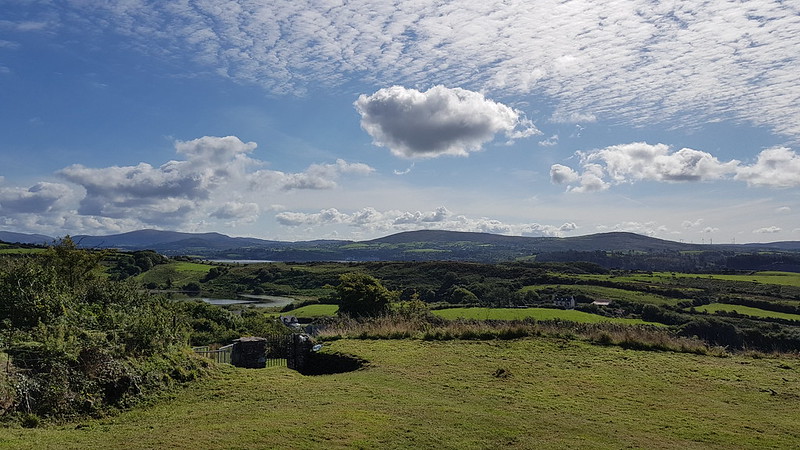
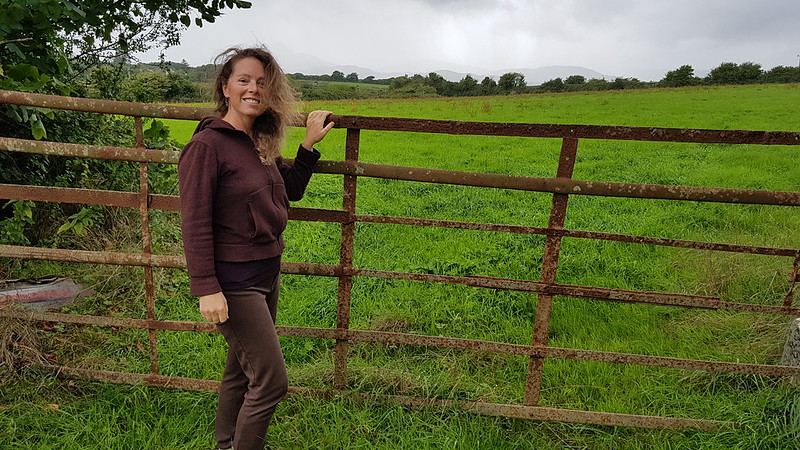

On the last day of August, we realized that it would be a good idea to move on – there was exploring to be done and we needed to get to Scotland – our chosen winter over spot - on or around October first. So we hopped down the coast, visiting many scenic little spots such as Whiddy Island and Glengariff and Baltimore, before rounding the bottom of Ireland (Fastnet Rock!!) and heading north in the Irish Sea. The cruising continued – Kinsale, Youghal (pronounced Y’all), Rosslare, Arklow, Dun Laoghaire, Newry – and soon we found ourselves in Bangor, quite close to Belfast.


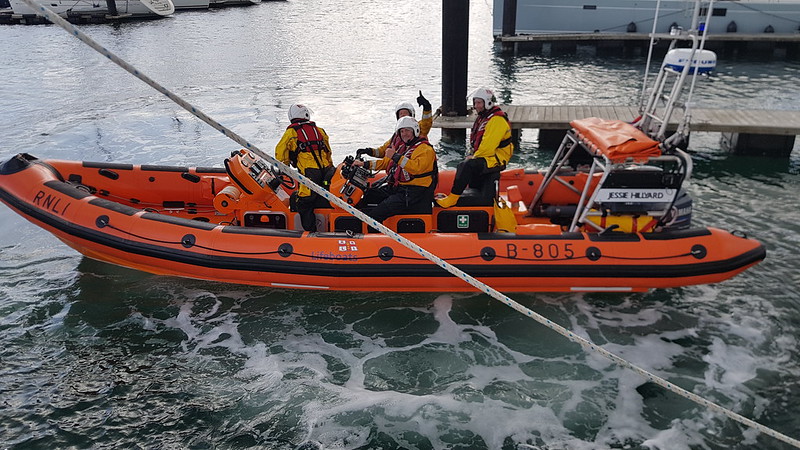
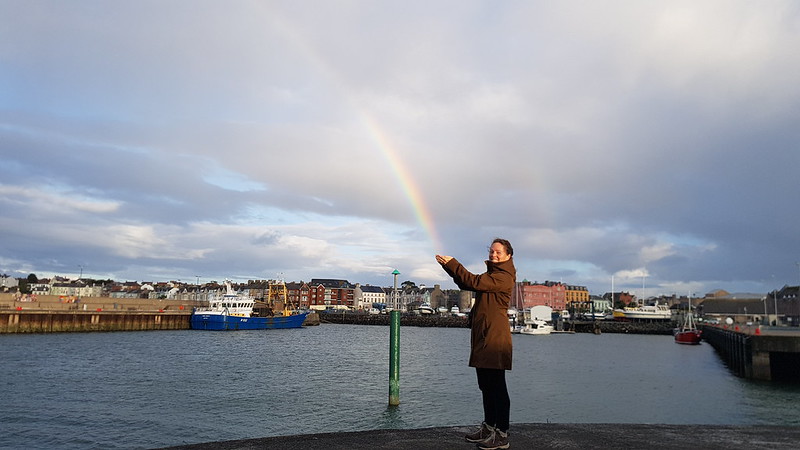
Tied up at the Bangor Marina we enjoyed rare and wonderful hot baths! The virtual pot of gold at the end of the Bangor rainbow. Natural hot springs aside, the only other actual bath tub with hot water that we have ever found cruising (world wide!) was at Club Nautico Reloncavi, Puerto Montt in Chile.

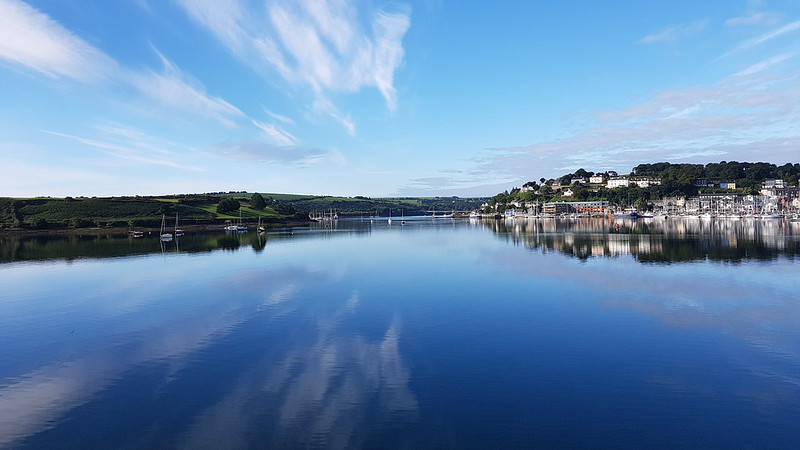
From Bangor, it is only a long daysail across the Irish Sea to Scotland. We sailed up the Firth of Clyde on the 24th of September in squally weather and cold rain. Our chosen winter spot (town of Ardrossan and Clyde Marina) is in an old basin lined with stone walls, formerly a coal loading station, and is protected by massive breakwaters bordering an outer basin and a big steel gate closes an inner basin (now with pontoons for small boats) during gales to further block waves and surge. Protection is good and the winter package prices for moorage and haulout are unmatched in the area. As we approached the narrow entrance we looked for a post with three vertical lights, finally spotting it and seeing the “all green” that meant we could proceed into the basin. The lights are there to warn any vessel to stand off if the gate was closed, or if the ferry was maneuvering in the outer basin to arrive or depart. It would be important not to go into the confines of the port at the wrong time – there is no excess of room to turn around and one would not want to be embayed and forced onto a rough rocky choppy lee breakwater or shore.

The first full-on Scottish gale of the fall season was arriving by the time Irene was safely tied up. The port staff closed the gate but the water in the basin was still a bit restless, surging back and forth and up and down. Irene heeled to the gusts, and we adjusted dock lines and fenders to ride the surge as comfortably as possible. We have learned that the trick is to tie up with enough slack in our docklines to allow the boat to move forward and aft and/or port to starboard just enough to “breathe” with the rhythm of the water, but set no excess slack so the boat doesn’t develop any extra movement. The up and down movement of the water is called surge, and (as we’ve learned here) the back and forth is called scend. In practice we judge amount of scend (by watching something floating on the surface of the water) and set the lines (spring lines especially if the scend is fore and aft) to allow the boat to move exactly that distance. If the springs are too short the boat snatches horribly every few seconds as 25 tons tries to move back and forth but is stopped short suddenly. The resulting snatch in the motion can tip over any item not tied down and makes walking onboard difficult. In contrast when the lines are adjusted perfectly, items on the table stay put and walking is easy, even though our 25 ton boat is actually moving back and forth a few feet.
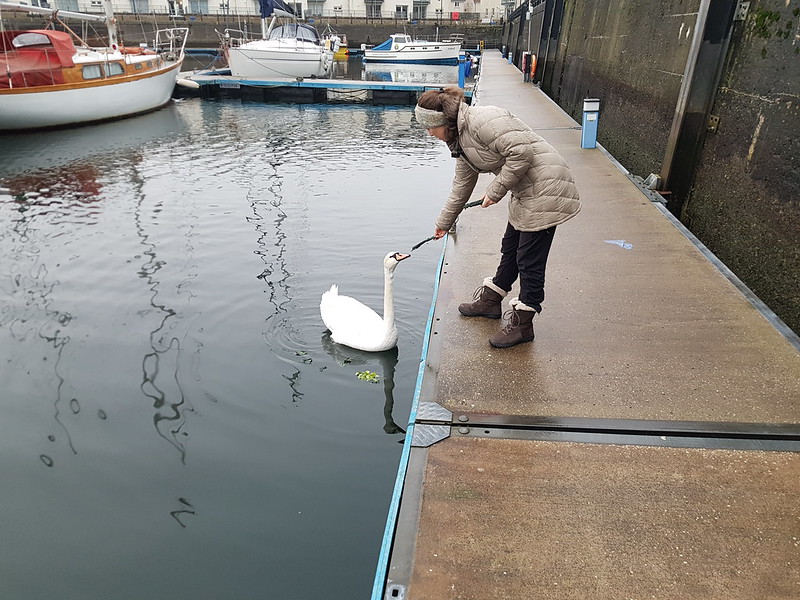

As we write this report we’ve been in our snug Scottish berth for three months. Our normal winter repairs are well underway. In November Irene was hauled out and we applied a coat of antifoul on her bottom, and we already back in our berth. We had noticed one of the fittings on the mast had sprung out a bit, so we had the mast pulled out of the boat for inspection. We found two damaged sections of wood on the spar that are being patched up now. We’ve added a radiator to the saloon (comfy!) that is heated by the diesel heating stove. We are also working on revising our HF radio setup, converting two more shrouds from stainless to dyneema fiber and keeping up with the usual varnishing and painting. We are planning our next sailing season, catching up with blog posts, reading, and various Netflix series and movies.
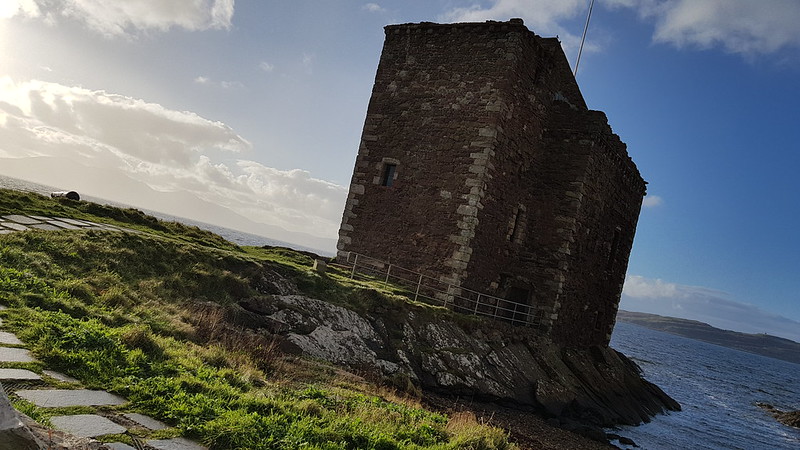
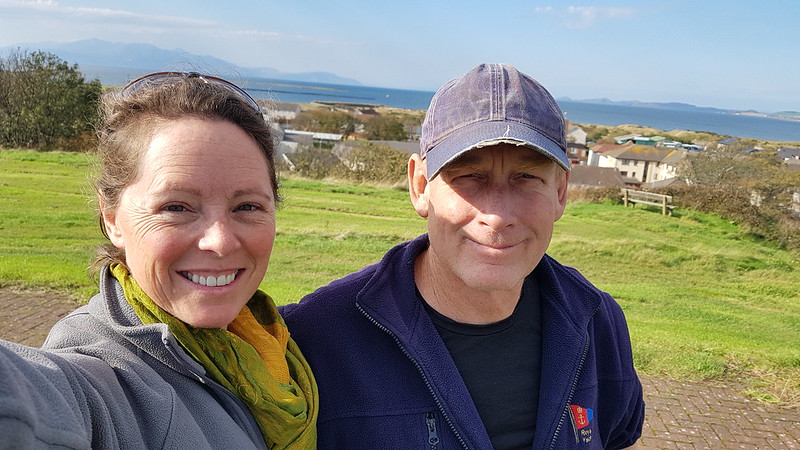
It is no accident that we ended up in Ardrossan. We were steered here by Heather and Mark of Larissa. Larissa transited the Northwest Passage the same year as Irene, and after wintering in Greenland, they crossed via Iceland and the Orkneys to Scotland. Heather is from Scotland originally and carefully researched many UK options before deciding that Ardrossan had the edge. Affordability, shelter, transportation, and services and facilities were considered. Knowing their priorities are similar to ours made it easy to decide to tag along.
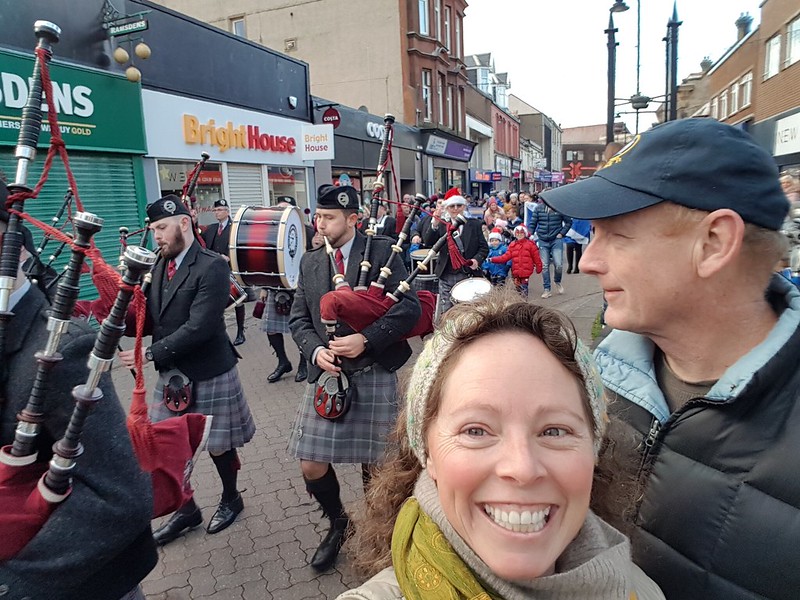
One of the good things about our location is that it is just a short walk from the boat to the train station, ferry terminal, grocery store, bus stop, and a few restaurants. We crave walking after being cooped up on the boat. We’ve walked to nearby town of Saltcoats several times.
We’ve taken the train to Glasgow and Helensborough, and plan to explore further over the next couple of months. Heather and Mark drove us to Loch Lomond for a hike, and with them we took the ferry across to Arran Island to climb to the summit of Goatfell. Irene is warm and cheery down below and it has not been difficult for us to adjust to the legendary nasty Scottish weather! Though we are looking forward to increasing daylight. On winter solstice our day was a bit less than seven hours of feeble weak light.
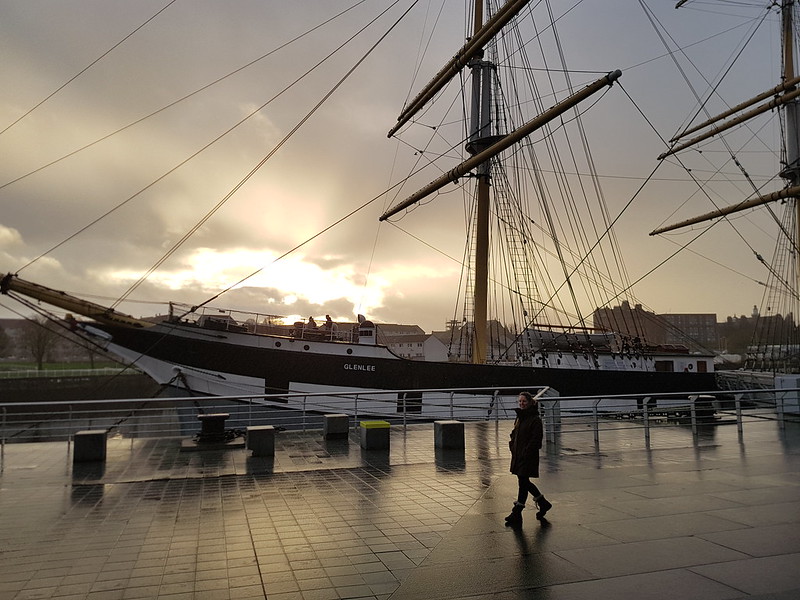
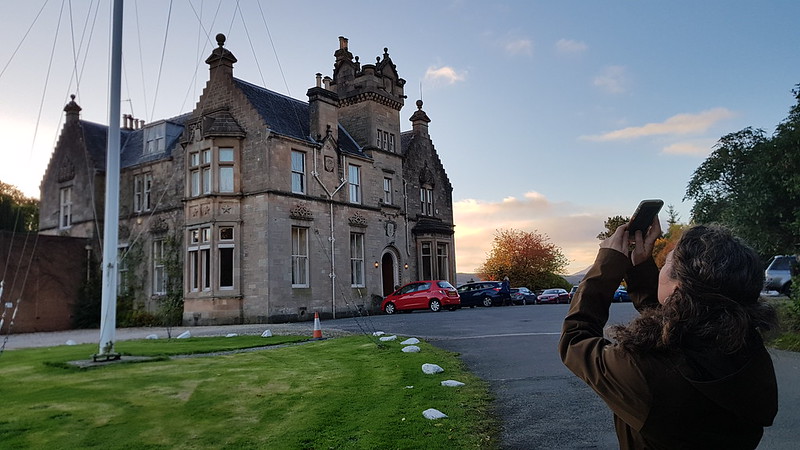

We departed on a Friday – August 3rd, 2018 – in violation of the prohibition “Never Set Sail on a Friday.” We tend to take sailor’s superstitions with a grain of salt. After all, there are so many of them! So we whistle when we are cheerful, carry bananas aboard when we can, and don’t worry in the least that half our crew are women. The weather looked good for us with just the right wind, not too much or too little, and that’s much more important than any old superstition.

The first few days we sailed closehauled in thick fog towards the south coast of Newfoundland. As we got closer to the island the wind backed until we were forced to tack to clear Cape Race. So, Irene zig zagged her way up the great circle route. This is a rare thing for us – sailing upwind on the open ocean – we usually don't to avoid boat damage and crew fatigue, and often progress is minimal - but this time our options were limited by land to the north. We found that even though it was impossible to cook (beyond boiling water) the waves were small enough that we were making good progress. We were running out of sea room on starboard tack (the favored tack) as we closed in on Cape Race so going about was needed if we wanted to go to Ireland instead of South Africa.
An interesting thing happened on one of Ginger’s watches. She could hear half of a VHF conversation between a helicopter and a distant Coast Guard ship or shore station. She realized that the helicopter was reporting the status of a capsized but still floating fishing vessel – definitely a danger to us day or night considering that the fog was so thick we couldn’t see Irene’s bow clearly even at high noon. And radar couldn’t be expected to reliably pick up a target awash in the waves. Luckily, at one point the helicopter pilot reported the position of this wreck (the Tommy Evans) which Ginger marked on the chartplotter so we knew where not to go. Good thing, too – our course took us just a few miles from the floating wreck.

The fog stuck with us for ten days. Then on one glorious morning, the sun came up! We enjoyed a couple of days of weak sun and light winds, still making good progress on the great circle course. Our HF radio was not working, when we spotted a bulk carrier heading our way we gave him a call to get a weather update. The watch officer answered quickly, but his weather information was limited, and all he could tell us was that there were no storm warnings in the next two days! We notice that with increased use weather routing services that many commercial ships officers aren’t as informed about weather as they were in the old days. It didn’t really matter to us because we don’t have the speed to maneuver around storms – once committed to a crossing we take what we get – but it is sometimes nice to know what is coming. Normally at sea we get good information (gribs) over HF radio but we had been plagued with a recurring problem on this passage. Our radio is working perfectly coastwise but won’t tune at sea! Intermittent faults are so hard to diagnose.
On day twelve the fog closed back down on us. This mid ocean fog was not quite as thick as the Canadian version and we could see Irene’s foredeck just fine, but we weren’t going to get suntanned or get any power from the solar panels. We ran the motor for a few hours every other day and charged the batteries, made water, and ran our Russian made hydronic heater to warm up and dry out the cabin.
On the fourteenth, we were visited by surfing pilot whales and dolphins. It was so nice to see fellow mammals on the high seas! Ginger cooked up a magnificent sausage and egg breakfast and we ran the heater for hot water baths and hair washing. Life can be very good at sea.


7.77 hPa drop in 3 hours means lots of wind is coming!
The barometer started to plummet so we expected some weather to arrive. Gradually wind and sea rose, and sails were reefed and furled in sequence. We sailed on under jib for 24 hours. By nightfall that next night we were sailing under a scrap of jib alone. By two in the morning Irene was taking a beating, so we lashed the tiller down to leeward. Time to park the boat! Irene’s motion eased and her crew headed down below to take it easy. We checked for traffic (there was none) every fifteen minutes by radar or going out on deck for a look, but mostly we stayed wedged in our storm bunks. Twenty eight hours later we could hear the wind easing and were able to resume sailing, under jib and reefed mizzen, just as the weak dawn revealed a bleak wild seascape of tumbling breakers. We later found out that we had ridden out subtropical storm Debby.
Two days later, the barometer started dropping again (with a sharper drop this time) and we repeated the same process of progressively reducing sail and before long we were hove to again. We were a mere 88 miles from Ireland. At 3:30 AM on August 19, nine hours later, we were able to set a bit of sail and head towards Bantry Bay, on the west coast of Ireland. We later found out that we had ridden out subtropical storm Ernesto. Sheesh! Still, by North Atlantic standards, our foggy (all but two days) crossing had gone well.



By late afternoon we were well into Bantry Bay and were catching our first glimpses of fog shrouded green Irish shores. By early evening we were tied up to a pontoon at the old Bantry breakwater and were finding out how lucky our choice of landfall was. We had expected to anchor (our chart and pilot book information showed no pontoons or floats) so the newly installed pontoons were a pleasant surprise. There was no need to launch the dinghy to get ashore. And fresh water was available on the pontoon to rinse Irene’s salt soaked decks and rigging and swap out our heat exchanger. The moorage fee was reasonable, a large grocery store was nearby, and the picturesque town was all that we hoped a small Irish town might be. We enjoyed our first pint of Guinness in an ancient dark pub and toasted to the safe crossing. It was a respectably quick one at 16 days, too, especially if you subtract the day and a half we had spent hove to!


We were only in Bantry a day before a mutual friend in South Africa reunited us with Trevor on Ironbark, last seen in Chile. Ironbark is a 35 foot steel gaff cutter, and Trevor is an amazing singlehander who casually sails from ocean to ocean spending an enormous amount of time in cold and stormy places. He’s wintered over on Ironbark in both the Arctic and the Antarctic! He had recently arrived from New Zealand by way of Antarctica and the Falkland Islands. Trevor spends a lot of time sailing stormy seasons and stormy parts of the world (including the Southern Ocean) and uses his Jordan series drogue seriously. The 2018 Golden Globe racers (there are now three rescues and abandoned boats due to pitch poles, rollovers, dismasting) could maybe learn from him - check out his thoughts and opinions at iron-bark.blogspot.com.



On the last day of August, we realized that it would be a good idea to move on – there was exploring to be done and we needed to get to Scotland – our chosen winter over spot - on or around October first. So we hopped down the coast, visiting many scenic little spots such as Whiddy Island and Glengariff and Baltimore, before rounding the bottom of Ireland (Fastnet Rock!!) and heading north in the Irish Sea. The cruising continued – Kinsale, Youghal (pronounced Y’all), Rosslare, Arklow, Dun Laoghaire, Newry – and soon we found ourselves in Bangor, quite close to Belfast.




Tied up at the Bangor Marina we enjoyed rare and wonderful hot baths! The virtual pot of gold at the end of the Bangor rainbow. Natural hot springs aside, the only other actual bath tub with hot water that we have ever found cruising (world wide!) was at Club Nautico Reloncavi, Puerto Montt in Chile.


From Bangor, it is only a long daysail across the Irish Sea to Scotland. We sailed up the Firth of Clyde on the 24th of September in squally weather and cold rain. Our chosen winter spot (town of Ardrossan and Clyde Marina) is in an old basin lined with stone walls, formerly a coal loading station, and is protected by massive breakwaters bordering an outer basin and a big steel gate closes an inner basin (now with pontoons for small boats) during gales to further block waves and surge. Protection is good and the winter package prices for moorage and haulout are unmatched in the area. As we approached the narrow entrance we looked for a post with three vertical lights, finally spotting it and seeing the “all green” that meant we could proceed into the basin. The lights are there to warn any vessel to stand off if the gate was closed, or if the ferry was maneuvering in the outer basin to arrive or depart. It would be important not to go into the confines of the port at the wrong time – there is no excess of room to turn around and one would not want to be embayed and forced onto a rough rocky choppy lee breakwater or shore.

The first full-on Scottish gale of the fall season was arriving by the time Irene was safely tied up. The port staff closed the gate but the water in the basin was still a bit restless, surging back and forth and up and down. Irene heeled to the gusts, and we adjusted dock lines and fenders to ride the surge as comfortably as possible. We have learned that the trick is to tie up with enough slack in our docklines to allow the boat to move forward and aft and/or port to starboard just enough to “breathe” with the rhythm of the water, but set no excess slack so the boat doesn’t develop any extra movement. The up and down movement of the water is called surge, and (as we’ve learned here) the back and forth is called scend. In practice we judge amount of scend (by watching something floating on the surface of the water) and set the lines (spring lines especially if the scend is fore and aft) to allow the boat to move exactly that distance. If the springs are too short the boat snatches horribly every few seconds as 25 tons tries to move back and forth but is stopped short suddenly. The resulting snatch in the motion can tip over any item not tied down and makes walking onboard difficult. In contrast when the lines are adjusted perfectly, items on the table stay put and walking is easy, even though our 25 ton boat is actually moving back and forth a few feet.


As we write this report we’ve been in our snug Scottish berth for three months. Our normal winter repairs are well underway. In November Irene was hauled out and we applied a coat of antifoul on her bottom, and we already back in our berth. We had noticed one of the fittings on the mast had sprung out a bit, so we had the mast pulled out of the boat for inspection. We found two damaged sections of wood on the spar that are being patched up now. We’ve added a radiator to the saloon (comfy!) that is heated by the diesel heating stove. We are also working on revising our HF radio setup, converting two more shrouds from stainless to dyneema fiber and keeping up with the usual varnishing and painting. We are planning our next sailing season, catching up with blog posts, reading, and various Netflix series and movies.


It is no accident that we ended up in Ardrossan. We were steered here by Heather and Mark of Larissa. Larissa transited the Northwest Passage the same year as Irene, and after wintering in Greenland, they crossed via Iceland and the Orkneys to Scotland. Heather is from Scotland originally and carefully researched many UK options before deciding that Ardrossan had the edge. Affordability, shelter, transportation, and services and facilities were considered. Knowing their priorities are similar to ours made it easy to decide to tag along.

One of the good things about our location is that it is just a short walk from the boat to the train station, ferry terminal, grocery store, bus stop, and a few restaurants. We crave walking after being cooped up on the boat. We’ve walked to nearby town of Saltcoats several times.
We’ve taken the train to Glasgow and Helensborough, and plan to explore further over the next couple of months. Heather and Mark drove us to Loch Lomond for a hike, and with them we took the ferry across to Arran Island to climb to the summit of Goatfell. Irene is warm and cheery down below and it has not been difficult for us to adjust to the legendary nasty Scottish weather! Though we are looking forward to increasing daylight. On winter solstice our day was a bit less than seven hours of feeble weak light.


Ah, thank you for the vicarious Atlantic crossing! So glad you're settled in such a lovely spot for the winter. We are waiting for the sun's return here as well.
ReplyDelete